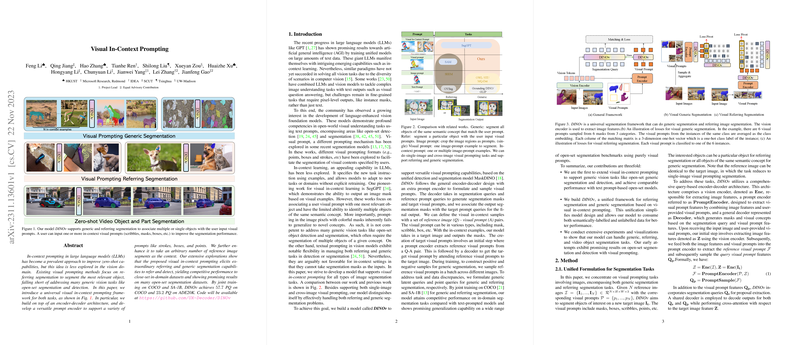Visual In-Context Prompting: An Overview
The paper "Visual In-Context Prompting" introduces a novel framework, DINOv, that expands the capabilities of visual prompting for vision tasks. The framework is designed specifically to tackle both generic and referring segmentation challenges by leveraging in-context visual prompts.
The research builds on the existing foundation of LLMs and adapts the in-context prompting mechanism—highly effective in LLMs—to the visual domain. Traditional text-based visual perception methods rely heavily on textual descriptions, which can be ambiguous or misaligned with real-world visual complexities. DINOv aims to address these limitations by utilizing visual inputs like strokes, boxes, and points, providing a more concrete basis for segmentation tasks.
Methodology
DINOv operates on an encoder-decoder architecture enhanced with a versatile prompt encoder. The framework takes a target image, along with reference visual prompts, and processes them to extract meaningful segmentation tasks. The visual prompts serve as a guide to the model, informing it of the areas of interest within the image, which can range from single objects to multiple instances of the same semantic concept.
Significantly, the research addresses two main types of segmentation tasks: generic segmentation and referring segmentation. For generic segmentation, DINOv considers all instances of a semantic category, whereas referring segmentation focuses on a particular instance as specified by the user-provided visual prompt.
Numerical Results and Evaluation
The framework's efficacy is demonstrated through extensive experiments across various datasets, including COCO and ADE20K for in-domain and out-domain tasks respectively. On the COCO dataset, DINOv achieved a Panoptic Quality (PQ) score of 57.7, while on ADE20K, it attained a PQ score of 23.2. These results position DINOv comparably against leading models like Mask DINO for in-domain tasks and showcase its promising generalization capabilities for open-set tasks.
Moreover, DINOv was tested for segmentation in the wild and object detection across diverse datasets, where it achieved significant improvements over existing frameworks, particularly those using visual prompts.
Implications and Future Directions
The research outlines several key implications for the field of computer vision. By introducing a unified framework that accommodates both semantic and task-specific data, DINOv emphasizes the potential of visual prompts to offer flexibility and adaptability in computational vision tasks. Unlike models relying on large pre-trained text encoders, DINOv manages to achieve competitive open-set segmentation performance using a significantly streamlined approach with visual prompts.
The successful application of visual in-context prompting opens new avenues for future exploration. It presents opportunities for refining segmentation accuracy and expanding adaptive capabilities beyond traditional methods. The paper also hints at the potential for integrating visual and multi-modal prompting techniques in AI models for more comprehensive and context-aware vision systems.
In conclusion, while DINOv establishes a robust foundation for visual prompting in segmentation tasks, further research could explore scaling training data or incorporating text prompts, offering a multi-dimensional approach to vision tasks. This could enhance both theoretical understanding and practical applications, contributing to more versatile and efficient AI systems.
